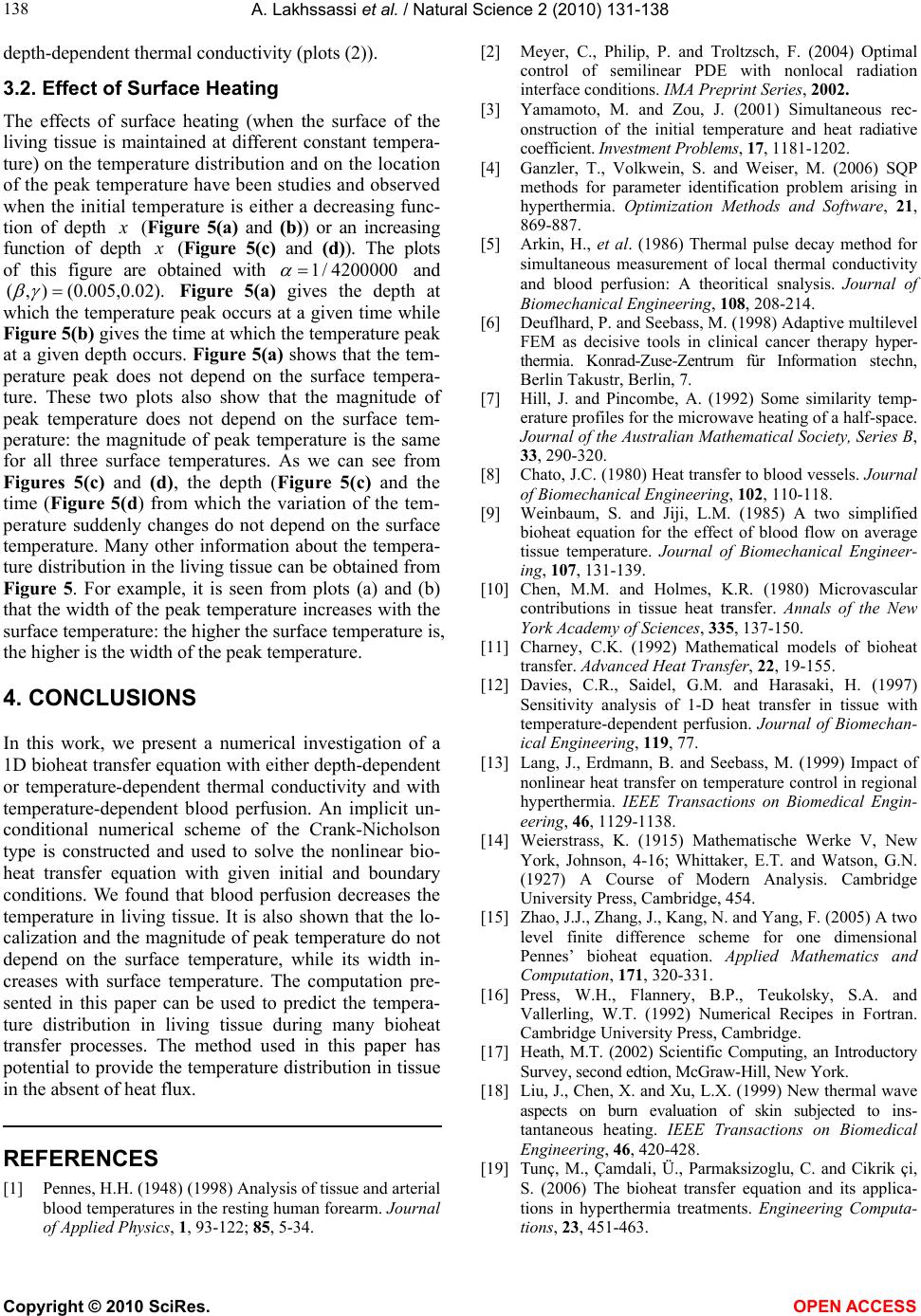
A. Lakhssassi et al. / Natural Science 2 (2010) 131-138
Copyright © 2010 SciRes. OPEN ACCESS
138
depth-dependent thermal conductivity (plots (2)).
3.2. Effect of Surface Heating
The effects of surface heating (when the surface of the
living tissue is maintained at different constant tempera-
ture) on the temperature distribution and on the location
of the peak temperature have been studies and observed
when the initial temperature is either a decreasing func-
tion of depth
(Figure 5(a) and (b)) or an increasing
function of depth
(Figure 5(c) and (d)). The plots
of this figure are obtained with 1/ 4200000
and
(, )(0.005,0.02).
Figure 5(a) gives the depth at
which the temperature peak occurs at a given time while
Figure 5(b) gives the time at which the temperature peak
at a given depth occurs. Figure 5(a) shows that the tem-
perature peak does not depend on the surface tempera-
ture. These two plots also show that the magnitude of
peak temperature does not depend on the surface tem-
perature: the magnitude of peak temperature is the same
for all three surface temperatures. As we can see from
Figures 5(c) and (d), the depth (Figure 5(c) and the
time (Figure 5(d) from which the variation of the tem-
perature suddenly changes do not depend on the surface
temperature. Many other information about the tempera-
ture distribution in the living tissue can be obtained from
Figure 5. For example, it is seen from plots (a) and (b)
that the width of the peak temperature increases with the
surface temperature: the higher the surface temperature is,
the higher is the width of the peak temperature.
4. CONCLUSIONS
In this work, we present a numerical investigation of a
1D bioheat transfer equation with either depth-dependent
or temperature-dependent thermal conductivity and with
temperature-dependent blood perfusion. An implicit un-
conditional numerical scheme of the Crank-Nicholson
type is constructed and used to solve the nonlinear bio-
heat transfer equation with given initial and boundary
conditions. We found that blood perfusion decreases the
temperature in living tissue. It is also shown that the lo-
calization and the magnitude of peak temperature do not
depend on the surface temperature, while its width in-
creases with surface temperature. The computation pre-
sented in this paper can be used to predict the tempera-
ture distribution in living tissue during many bioheat
transfer processes. The method used in this paper has
potential to provide the temperature distribution in tissue
in the absent of heat flux.
REFERENCES
[1] Pennes, H.H. (1948) (1998) Analysis of tissue and arterial
blood temperatures in the resting human forearm. Journal
of Applied Physics, 1, 93-122; 85, 5-34.
[2] Meyer, C., Philip, P. and Troltzsch, F. (2004) Optimal
control of semilinear PDE with nonlocal radiation
interface conditions. IMA Preprint Series, 2002.
[3] Yamamoto, M. and Zou, J. (2001) Simultaneous rec-
onstruction of the initial temperature and heat radiative
coefficient. Investment Problems, 17, 1181-1202.
[4] Ganzler, T., Volkwein, S. and Weiser, M. (2006) SQP
methods for parameter identification problem arising in
hyperthermia. Optimization Methods and Software, 21,
869-887.
[5] Arkin, H., et al. (1986) Thermal pulse decay method for
simultaneous measurement of local thermal conductivity
and blood perfusion: A theoritical snalysis. Journal of
Biomechanical Engineering, 108, 208-214.
[6] Deuflhard, P. and Seebass, M. (1998) Adaptive multilevel
FEM as decisive tools in clinical cancer therapy hyper-
thermia. Konrad-Zuse-Zentrum für Information stechn,
Berlin Takustr, Berlin, 7.
[7] Hill, J. and Pincombe, A. (1992) Some similarity temp-
erature profiles for the microwave heating of a half-space.
Journal of the Australian Mathematical Society, Series B,
33, 290-320.
[8] Chato, J.C. (1980) Heat transfer to blood vessels. Journal
of Biomechanical Engineering, 102, 110-118.
[9] Weinbaum, S. and Jiji, L.M. (1985) A two simplified
bioheat equation for the effect of blood flow on average
tissue temperature. Journal of Biomechanical Engineer-
ing, 107, 131-139.
[10] Chen, M.M. and Holmes, K.R. (1980) Microvascular
contributions in tissue heat transfer. Annals of the New
York Academy of Sciences, 335, 137-150.
[11] Charney, C.K. (1992) Mathematical models of bioheat
transfer. Advanced Heat Transfer, 22, 19-155.
[12] Davies, C.R., Saidel, G.M. and Harasaki, H. (1997)
Sensitivity analysis of 1-D heat transfer in tissue with
temperature-dependent perfusion. Journal of Biomechan-
ical Engineering, 119, 77.
[13] Lang, J., Erdmann, B. and Seebass, M. (1999) Impact of
nonlinear heat transfer on temperature control in regional
hyperthermia. IEEE Transactions on Biomedical Engin-
eering, 46, 1129-1138.
[14] Weierstrass, K. (1915) Mathematische Werke V, New
York, Johnson, 4-16; Whittaker, E.T. and Watson, G.N.
(1927) A Course of Modern Analysis. Cambridge
University Press, Cambridge, 454.
[15] Zhao, J.J., Zhang, J., Kang, N. and Yang, F. (2005) A two
level finite difference scheme for one dimensional
Pennes’ bioheat equation. Applied Mathematics and
Computation, 171, 320-331.
[16] Press, W.H., Flannery, B.P., Teukolsky, S.A. and
Vallerling, W.T. (1992) Numerical Recipes in Fortran.
Cambridge University Press, Cambridge.
[17] Heath, M.T. (2002) Scientific Computing, an Introductory
Survey, second edtion, McGraw-Hill, New York.
[18] Liu, J., Chen, X. and Xu, L.X. (1999) New thermal wave
aspects on burn evaluation of skin subjected to ins-
tantaneous heating. IEEE Transactions on Biomedical
Engineering, 46, 420-428.
[19] Tunç, M., Çamdali, Ü., Parmaksizoglu, C. and Cikrik çi,
S. (2006) The bioheat transfer equation and its applica-
tions in hyperthermia treatments. Engineering Computa-
tions, 23, 451-463.